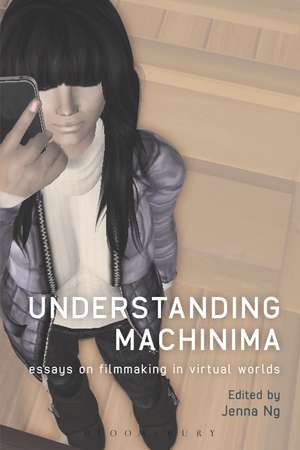Understanding Machinima: Essays on Filmmaking in Virtual Worlds
Editat de Jenna Ngen Limba Engleză Paperback – 11 sep 2013
| Toate formatele și edițiile | Preț | Express |
|---|---|---|
| Paperback (1) | 239.59 lei 6-8 săpt. | |
| Bloomsbury Publishing – 11 sep 2013 | 239.59 lei 6-8 săpt. | |
| Hardback (1) | 831.43 lei 6-8 săpt. | |
| Bloomsbury Publishing – 11 sep 2013 | 831.43 lei 6-8 săpt. |
Preț: 239.59 lei
Preț vechi: 306.72 lei
-22% Nou
Puncte Express: 359
Preț estimativ în valută:
45.85€ • 49.79$ • 38.51£
45.85€ • 49.79$ • 38.51£
Carte tipărită la comandă
Livrare economică 22 aprilie-06 mai
Preluare comenzi: 021 569.72.76
Specificații
ISBN-13: 9781441104489
ISBN-10: 1441104488
Pagini: 296
Ilustrații: 15
Dimensiuni: 152 x 229 x 23 mm
Greutate: 0.45 kg
Editura: Bloomsbury Publishing
Colecția Bloomsbury Academic
Locul publicării:New York, United States
ISBN-10: 1441104488
Pagini: 296
Ilustrații: 15
Dimensiuni: 152 x 229 x 23 mm
Greutate: 0.45 kg
Editura: Bloomsbury Publishing
Colecția Bloomsbury Academic
Locul publicării:New York, United States
Caracteristici
Each chapter begins with a QR code, leading the reader to a mobile website with updated material, chapter outlines, images and machinima
Notă biografică
Jenna Ng is Anniversary Research Lecturer in Film and Interactive Media at the University of York, UK. She was previously a Newton Trust/Leverhulme Early Career Fellow at the Centre for Research in the Arts, Social Sciences and Humanities (CRASSH), University of Cambridge, UK.
Cuprins
Acknowledgements Preface Henry Lowood Introduction Jenna Ng I. Thinking Machinima1. Machinima: Cinema in a minor or multitudinous key? William Brown and Matthew Holtmeier 2. Beyond Bullet Time: Media in the knowable space Chris Burke 3. Be(ing)Dazzled: Living in machinima Sheldon Brown 4. Moving Digital Puppets Michael Nitsche, Ali Mazalek and Paul Clifton 5. Facing the Audience: A dialogic perspective on the hybrid animated film Lisbeth Frølunde 6. Dangerous Sim Crossings: Framing the Second Life art machinima Sarah Higley II. Using Machinima7. The Art of Games: Machinima and the limits of art games Larissa Hjorth 8. Playing Politics: Machinima as live performance and document Joseph DeLappe 9. Virtual Lens of Exposure: Aesthetics, theory, and ethics of documentary filmmaking in Second Life Sandra Danilovic 10. Call It a Vision Quest: Machinima in a First Nations context Beth Aileen Dillon and Jason Edward Lewis 11. World of Chaucer: Adaptation, pedagogy, and interdisciplinarity Chris Moore and Graham Barwell 12. A Pedagogy of Craft: Teaching Culture Analysis with machinima Jenna Ng and James Barrett Agency, Simulation, Gamification, Machinima: An interview with Isabelle Arvers Isabelle Arvers and Jenna Ng Notes on Contributors Glossary Index
Recenzii
This welcome anthology helps usher machinima out of the gamer niche and into the nexus of digital animation, cinema, and art video. As the chapters of this book demonstrate, machinima realizes new ways of documenting and archiving the mediality of our set-up, far beyond the early ambitions of entertainment convergence.
Understanding Machinima is a timely and much needed intervention in Machinima studies. Comprising an excellent range of contributors, this collection focuses on Machinima's diversity of use at the same time as it considers its many media specificities, making it a necessary resource to any scholar working in the field.
Understanding Machinima: Essays on Filmmaking in Virtual Worlds, is personable yet edgy, conversational yet controversial. The chapters draw on personal reflection, Spinal Tap, mixed reality, Sesame Street, Bakhtin's dialogic theory, Chaucer, Iraq, First Nations, and psychoanalysis, yet they are clear and lucid. I found much to engage with, and even more to debate with. The field of machinima scholarship is small but engaging, and Understanding Machinima is a worthy contribution.
As machinima has evolved an intersected with many different media, the study of machinima has become increasingly interdisciplinary. With this study, Ng (Univ. of York, UK) erases many of the boundaries that existed around the study of this art form to explore machinima as 'less a discrete, distinguishable media form than a fluid dialogue of and between media.' The second major theme of the collection is 'the diversity of this machinima world and how it sands against all other ralities - physical animated, virtual, blended, hybrid, augmented.' The collection gives equal attention to the theoretical and the practical, offering readers a divers selection of perspectives on machinima and related media. Some chapters take a fairly standard approach and examine machinima as digital puppetry and machinima in a First Nations context. This title would make an excellent complement to introductory texts on machinima because it offers a timely exploration of many aspects of machinima that will not be found in most other works on the subject. Summing Up: Highly recommended. Upper-division undergraduates through faculty.
Understanding Machinima is a timely and much needed intervention in Machinima studies. Comprising an excellent range of contributors, this collection focuses on Machinima's diversity of use at the same time as it considers its many media specificities, making it a necessary resource to any scholar working in the field.
Understanding Machinima: Essays on Filmmaking in Virtual Worlds, is personable yet edgy, conversational yet controversial. The chapters draw on personal reflection, Spinal Tap, mixed reality, Sesame Street, Bakhtin's dialogic theory, Chaucer, Iraq, First Nations, and psychoanalysis, yet they are clear and lucid. I found much to engage with, and even more to debate with. The field of machinima scholarship is small but engaging, and Understanding Machinima is a worthy contribution.
As machinima has evolved an intersected with many different media, the study of machinima has become increasingly interdisciplinary. With this study, Ng (Univ. of York, UK) erases many of the boundaries that existed around the study of this art form to explore machinima as 'less a discrete, distinguishable media form than a fluid dialogue of and between media.' The second major theme of the collection is 'the diversity of this machinima world and how it sands against all other ralities - physical animated, virtual, blended, hybrid, augmented.' The collection gives equal attention to the theoretical and the practical, offering readers a divers selection of perspectives on machinima and related media. Some chapters take a fairly standard approach and examine machinima as digital puppetry and machinima in a First Nations context. This title would make an excellent complement to introductory texts on machinima because it offers a timely exploration of many aspects of machinima that will not be found in most other works on the subject. Summing Up: Highly recommended. Upper-division undergraduates through faculty.





















